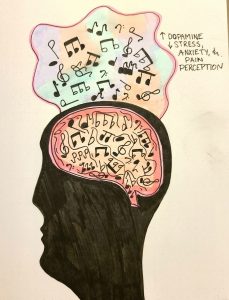
Music seems to be everywhere these days and serves a variety of purposes from person to person. Some use music to quell their nerves, others use it for focus measures, some may use it for working out, etc. Music provides a variety of purposes, including simple enjoyment. So, what is music actually doing in the brain at these times? Could music serve even more purpose and be used in medical rehabilitation settings? To answer these questions, we first have to dive into the neurochemistry behind the brain. Two of the biggest theories surrounding on how music works neurochemically is the reward, motivation, and pleasure pathway and the stress and arousal response system.
Inside the Brain
The Reward Pathway
When we listen to music, it is referred to as the consummatory phase. During this time, music serves as a reward stimulus and activates the reward pathway, releasing dopamine and endogenous opioids.
As seen in the figure below, dopamine release in the ventral tegmentum area (VTA) function to regulate motivation and goal-directed behaviors when music is serving as a reward stimulus and is mediated by the mesocorticolimbic system. Endogenous opioids are also released with dopamine in the nucleus accumbens (NAc)of the brain and are what provide the feeling of pleasure in the reward system. Using music as a form of reward allows for those short-term behavioral changes of inhibiting stress and/or anxiety and increasing pleasure and motivation.

Stress & Arousal Response
We know that music can serve as a calming technique to decrease stress levels, and the reward pathway is involved in that by providing pleasure. What happens in a stress response? During a stress response, the neuroendocrine, autonomic, metabolic, and immune system are all affected. The HPA Axis is activated during high stress, releasing high levels of cortisol, which is the primary stress hormone. It’s been found that while listening to music, specifically slow tempo, low pitch, and no lyric music, HPA activation is actually reduced at cortisol markers, resulting in lower stress levels. This helps protect the body against the neurotoxicity that long-term stress and anxiety produce. Taking this into account that music helps reduce stress and anxiety by increasing dopamine and endogenous opioid release and decreasing cortisol production, could music possibly be used in high pain medical situations like physical rehabilitation for chronic pain and/or post-surgery?
Music Therapy with Physical Therapy
Music therapy being incorporated during physical therapy sessions is a rather common occurrence in many chronic pain cases and cases involving gait issues. Studies have found that using music in these cases increases the patient’s motivation during the session but also helps to reduce their pain perception and muscle tension, most likely due to music’s effect on stress response and dopamine release. Music is able to provide a distraction element along with these neurochemical aspects to subjectively reduce pain because the patient’s cognitive attention is elsewhere with the music. This component of the consummatory phase of music makes it a great option to help patients experience less pain, anxiety, and muscle tension. The rhythm and tempo patterns in music seem to benefit gait therapy especially, helping the body fall into walking/marching with the beat. Using music in these more severe physical therapy cases seems to be extremely beneficial and are promising when even looking at acute pain. Incorporating background music or music therapy in most physical therapy sessions could serve as a great distraction for patients and give them an overall more enjoyable, motivated, and less painful therapy session.
References:
https://www.ncbi.nlm.nih.gov/pmc/articles/PMC3920463/
https://www.tandfonline.com/doi/full/10.1080/08098131.2010.485785?scroll=top&needAccess=true
https://pubmed.ncbi.nlm.nih.gov/20498613/